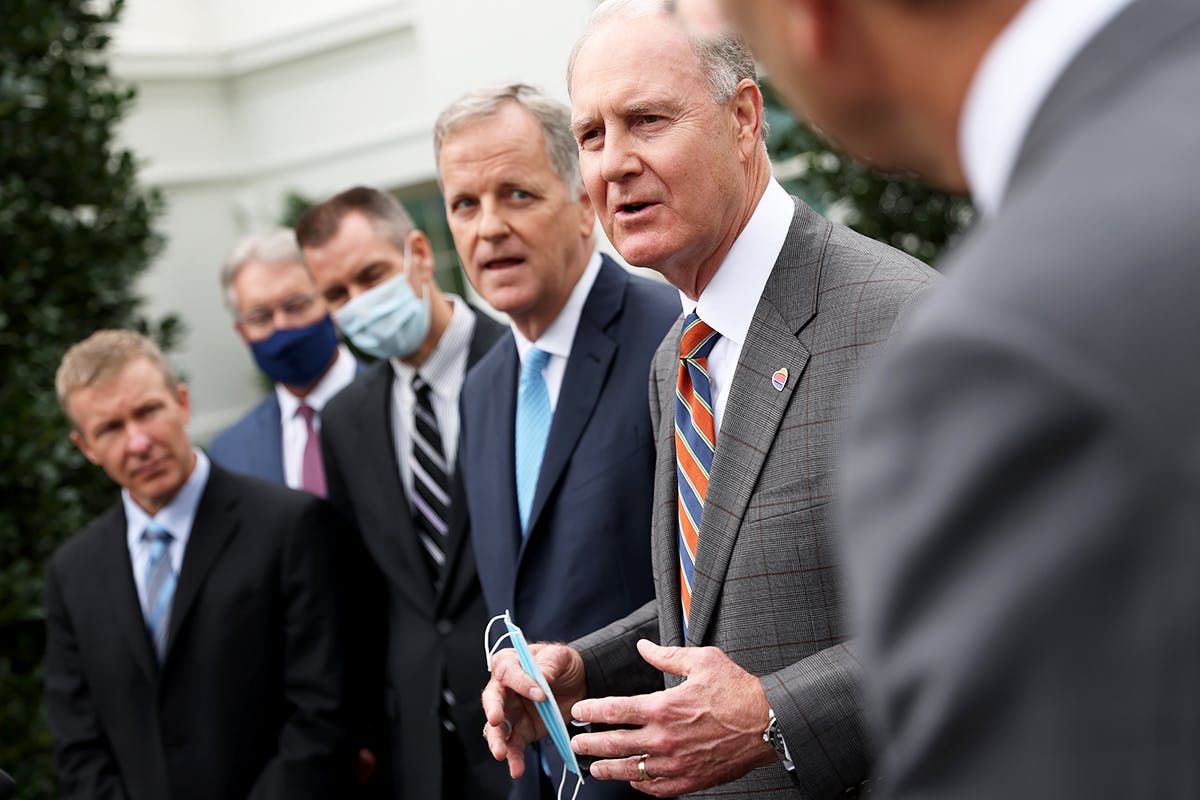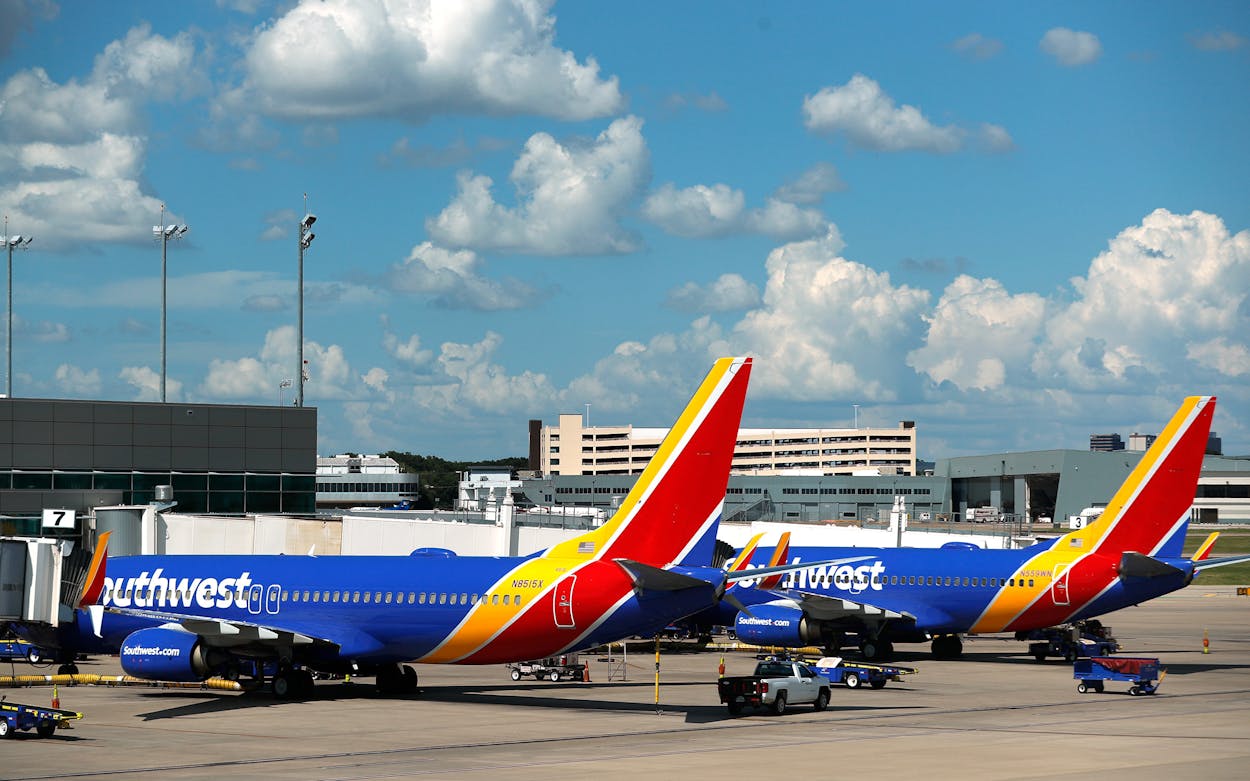For months, even as travel demand collapsed, Southwest Airlines held firm. In the interest of reducing the spread of COVID-19, the Dallas-based company limited the number of passengers on its flights. It remained committed to leaving its planes at least one-third empty, even as American Airlines, the other major carrier to call Texas home, infuriated the Twitterati this summer when it resumed filling every available seat.
Southwest’s stance seemed like a natural extension of its longtime reputation as a company unusually committed to customer-friendly policies. The airline routinely places at or near the top of major customer satisfaction ratings. During an early-summer uptick in demand, Southwest opted to add flights to its schedule, despite the additional costs involved, rather than fill the middle seats it had purposefully left empty since the pandemic began. Gary Kelly, the airline’s CEO since 2004, told Texas Monthly during a late-August interview that filling up planes would have been a better short-term business decision, “but, because we’re trying to reassure our customers and make sure that they have a good flight experience, something that they’re comfortable with so they’ll come back, we felt that that was the right decision.”
He left the door open, however, to resuming full flights once additional scientific studies validated the airline’s belief that the risk of the coronavirus spreading on its planes was low. It’s just such evidence—research from Harvard University, the Department of Defense, and the International Air Transport Association—that Southwest pointed to last week in announcing that it would unblock its middle seats starting December 1.
The carrier quickly drew much the same ire on social media that American Airlines had faced back in July. Many customers expressed disappointment. Some declared they would cancel plans to fly Southwest and would book instead on Delta, the only one of the country’s four biggest passenger airlines that will continue to block seats into 2021. The financial pain of the pandemic had apparently forced Southwest into a move that betrayed its passenger-friendly reputation.
With this decision, as well as others recently reported—that Southwest will fly into larger airports in Chicago and Houston that it had long avoided, and that it was finally considering adding a second type of plane to its fleet that famously has included only Boeing 737s—it seemed as though COVID-19 was pushing the airline away from the successful formula it had staunchly clung to for decades.
From a strictly financial viewpoint, it’s easy to see why Southwest would consider such changes. After cruising in 2019 to its forty-seventh straight year of profitability, earning $2.3 billion on revenue of $22.4 billion, the carrier watched the bottom drop out of its business in April. It and all the major carriers severely slashed their flight schedules, and their business has sputtered along since then. Losing between $16 million and $23 million daily, Southwest suffered net losses of $915 million and $1.2 billion in 2020’s second and third quarters, respectively.
The airline, which has never laid off or involuntarily furloughed any workers in its nearly five decades in business, offered early retirement or long-term leaves to many of its employees in July. About 17,000 of them, representing roughly 28 percent of its 60,000-person workforce, took the company up on those. These and other cost-cutting measures—Kelly is forgoing his salary, and he’s asked employees to take 10 percent pay cuts next year to avoid mandatory furloughs—will help Southwest save billions of dollars while many of its roughly 750 planes remain idle.

Gary Leff, the Austin-based author of an airline-industry website called View from the Wing, suspects the end of the federal government’s $3.3 billion in payroll support to the airline at the end of September played a big part in Southwest’s middle seat decision. Blocking those seats “was a very inexpensive thing for them to do early in the pandemic,” because the U.S. government’s money was paying the airline’s employees anyway. “It didn’t cost very much to add a flight if the flight was reaching its capacity limit,” Leff says. “All they had to do was cover the cost of fuel. Now it’s covering the cost of fuel, plus the staff. Southwest believes it would cost them $40 million a month to continue blocking middle seats going forward, so it no longer makes economic sense for them to do it.”
The airline also recently announced that it would begin flying to a number of new leisure-oriented destinations, including Palm Springs, California; Colorado Springs, Colorado; Montrose, Colorado; Jackson, Mississippi; and Savannah, Georgia. The industry expects leisure travel to outpace business travel for quite some time as the country recovers from the pandemic. In addition, Southwest is expanding into George Bush Intercontinental Airport in Houston and O’Hare International in Chicago. (It already dominates Houston’s Hobby Airport and Midway Airport in Chicago.) For decades, Southwest had preferred the lower costs of building its business by flying out of smaller, secondary airports in the nation’s largest markets. It formerly flew from Bush in Houston but pulled out fifteen years ago, saying its operations there were unprofitable.
On an October 22 earnings call, Southwest rebuffed the suggestion that any of this represents a fundamental shift in strategy. “At this point, with COVID, we’re actually in an aircraft surplus position, and now we’re able to put idle aircraft and our people to work, while at the same time strengthening existing markets on our network that are already very, very strong markets, like South Florida, California, Denver, Chicago and Houston,” said Tom Nealon, Southwest’s president.
Leff suspects the addition of Bush Intercontinental to Southwest’s network is specifically to take advantage of population growth to the north of the city. “They want to reach customers in a way that’s more convenient,” Leff says. “They compete more effectively in the Houston market by offering service to the north.”
To date, nearly all of Southwest’s service has been on Boeing 737s, a fact the carrier has long claimed gives it a competitive advantage because of easier scheduling and lower parts and training costs. Its current fleet includes more than five hundred Boeing 737-700s, more than two hundred 737-800s, and thirty-four 737 Max 8 jets. But the Max jets have been grounded since last year, after two fatal crashes in Indonesia and Ethiopia took the lives of 346 people. So Southwest has been eying the European-made Airbus A220, along with Boeing’s 737 Max 7 jet, as a replacement for some of its 737-700s over the next five to ten years. Both the Max 7 and the A220 are smaller, more fuel-efficient planes with lower operating costs.
“It makes all the sense in the world for Southwest to consider more than one product for its needs before they make a large aircraft order,” Leff says. “It doesn’t mean they aren’t going to stick with Boeing, since Southwest is arguably Boeing’s most important customer. Southwest will get incredibly good terms” whichever prevails, he says, because Boeing will be motivated to retain the carrier as a customer, and it would be an “incredible trophy” for Airbus to win Southwest’s business.
Southwest has long been studied as a model in business schools because of its remarkable run of profitability in an industry in which every other major carrier that was around as far back as the eighties has either declared bankruptcy or gone out of business (many swallowed up via mergers), as well as its reputation for great customer service. But, as the recent decision to unblock the middle seats makes clear, even Southwest is out to make money, and it can’t afford to stomach severe financial losses to keep passengers happy.
Aviation observers say Southwest’s loyal customers need not fear that the fun, quirky carrier will abandon its longtime commitment to zigging when other carriers zag—as least as long as Kelly remains in charge. Under the current CEO, they believe, the airline is apt to stick with its uniquely maverick choices—forgoing the billions of dollars in checked-bag fees that its rivals collect annually, offering no assigned or premium seating options—in its quest for growth.
“I think Southwest is always going to be different from a lot of other airlines. They’re always going to take a longer-term view,” says Seth Kaplan, a transportation analyst for NPR’s Hear & Now program and reporter for Irving-based Nexstar Media Group. “They’ve put themselves in position, after half a century of profit, to be able to wait. They don’t have to react to a crisis quite the way everybody else does.
“I think certain things are almost religion with them, like the no bag fees,” Kaplan adds. “But again, they have the ability to do that, because of the situation they’ve put themselves in over the years: being right a lot more often than they’ve been wrong.”
Meanwhile, Kelly’s hoping for more chances to be right, despite the pandemic. “I think the worst is behind us,” he told KRLD business analyst David Johnson on the CEO Spotlight radio show in Dallas last week. “Our business is off close to 70 percent, and the silver lining is that it’s not getting worse, it’s getting better. But this is not over, and we could have a very long way to go.”






